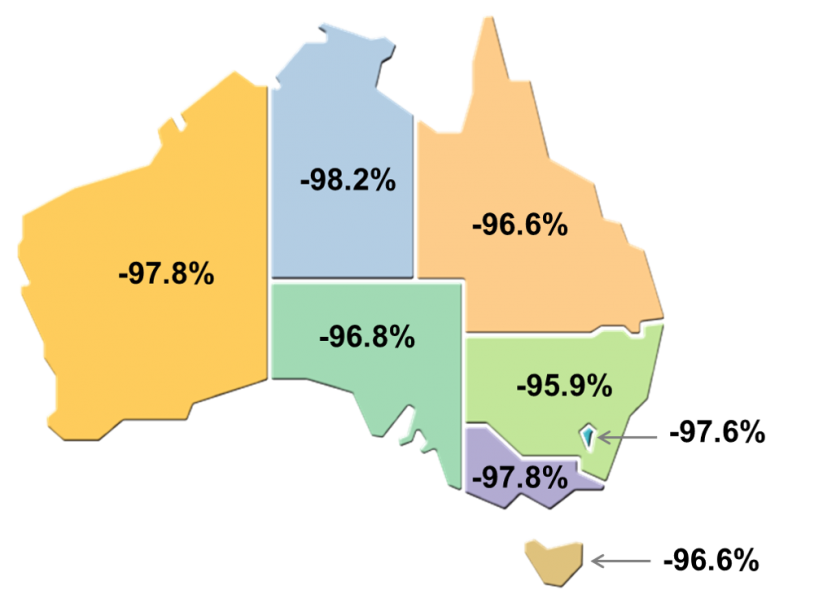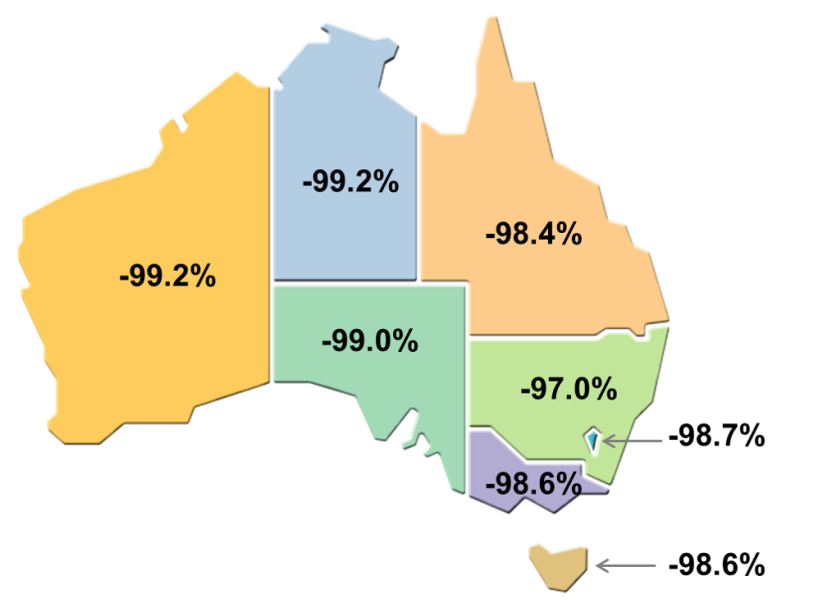13.2 Short-term visitor arrivals, Australia — year ending up to December 2020
[["Dec-80","Jan-81","Feb-81","Mar-81","Apr-81","May-81","Jun-81","Jul-81","Aug-81","Sep-81","Oct-81","Nov-81","Dec-81","Jan-82","Feb-82","Mar-82","Apr-82","May-82","Jun-82","Jul-82","Aug-82","Sep-82","Oct-82","Nov-82","Dec-82","Jan-83","Feb-83","Mar-83","Apr-83","May-83","Jun-83","Jul-83","Aug-83","Sep-83","Oct-83","Nov-83","Dec-83","Jan-84","Feb-84","Mar-84","Apr-84","May-84","Jun-84","Jul-84","Aug-84","Sep-84","Oct-84","Nov-84","Dec-84","Jan-85","Feb-85","Mar-85","Apr-85","May-85","Jun-85","Jul-85","Aug-85","Sep-85","Oct-85","Nov-85","Dec-85","Jan-86","Feb-86","Mar-86","Apr-86","May-86","Jun-86","Jul-86","Aug-86","Sep-86","Oct-86","Nov-86","Dec-86","Jan-87","Feb-87","Mar-87","Apr-87","May-87","Jun-87","Jul-87","Aug-87","Sep-87","Oct-87","Nov-87","Dec-87","Jan-88","Feb-88","Mar-88","Apr-88","May-88","Jun-88","Jul-88","Aug-88","Sep-88","Oct-88","Nov-88","Dec-88","Jan-89","Feb-89","Mar-89","Apr-89","May-89","Jun-89","Jul-89","Aug-89","Sep-89","Oct-89","Nov-89","Dec-89","Jan-90","Feb-90","Mar-90","Apr-90","May-90","Jun-90","Jul-90","Aug-90","Sep-90","Oct-90","Nov-90","Dec-90","Jan-91","Feb-91","Mar-91","Apr-91","May-91","Jun-91","Jul-91","Aug-91","Sep-91","Oct-91","Nov-91","Dec-91","Jan-92","Feb-92","Mar-92","Apr-92","May-92","Jun-92","Jul-92","Aug-92","Sep-92","Oct-92","Nov-92","Dec-92","Jan-93","Feb-93","Mar-93","Apr-93","May-93","Jun-93","Jul-93","Aug-93","Sep-93","Oct-93","Nov-93","Dec-93","Jan-94","Feb-94","Mar-94","Apr-94","May-94","Jun-94","Jul-94","Aug-94","Sep-94","Oct-94","Nov-94","Dec-94","Jan-95","Feb-95","Mar-95","Apr-95","May-95","Jun-95","Jul-95","Aug-95","Sep-95","Oct-95","Nov-95","Dec-95","Jan-96","Feb-96","Mar-96","Apr-96","May-96","Jun-96","Jul-96","Aug-96","Sep-96","Oct-96","Nov-96","Dec-96","Jan-97","Feb-97","Mar-97","Apr-97","May-97","Jun-97","Jul-97","Aug-97","Sep-97","Oct-97","Nov-97","Dec-97","Jan-98","Feb-98","Mar-98","Apr-98","May-98","Jun-98","Jul-98","Aug-98","Sep-98","Oct-98","Nov-98","Dec-98","Jan-99","Feb-99","Mar-99","Apr-99","May-99","Jun-99","Jul-99","Aug-99","Sep-99","Oct-99","Nov-99","Dec-99","Jan-00","Feb-00","Mar-00","Apr-00","May-00","Jun-00","Jul-00","Aug-00","Sep-00","Oct-00","Nov-00","Dec-00","Jan-01","Feb-01","Mar-01","Apr-01","May-01","Jun-01","Jul-01","Aug-01","Sep-01","Oct-01","Nov-01","Dec-01","Jan-02","Feb-02","Mar-02","Apr-02","May-02","Jun-02","Jul-02","Aug-02","Sep-02","Oct-02","Nov-02","Dec-02","Jan-03","Feb-03","Mar-03","Apr-03","May-03","Jun-03","Jul-03","Aug-03","Sep-03","Oct-03","Nov-03","Dec-03","Jan-04","Feb-04","Mar-04","Apr-04","May-04","Jun-04","Jul-04","Aug-04","Sep-04","Oct-04","Nov-04","Dec-04","Jan-05","Feb-05","Mar-05","Apr-05","May-05","Jun-05","Jul-05","Aug-05","Sep-05","Oct-05","Nov-05","Dec-05","Jan-06","Feb-06","Mar-06","Apr-06","May-06","Jun-06","Jul-06","Aug-06","Sep-06","Oct-06","Nov-06","Dec-06","Jan-07","Feb-07","Mar-07","Apr-07","May-07","Jun-07","Jul-07","Aug-07","Sep-07","Oct-07","Nov-07","Dec-07","Jan-08","Feb-08","Mar-08","Apr-08","May-08","Jun-08","Jul-08","Aug-08","Sep-08","Oct-08","Nov-08","Dec-08","Jan-09","Feb-09","Mar-09","Apr-09","May-09","Jun-09","Jul-09","Aug-09","Sep-09","Oct-09","Nov-09","Dec-09","Jan-10","Feb-10","Mar-10","Apr-10","May-10","Jun-10","Jul-10","Aug-10","Sep-10","Oct-10","Nov-10","Dec-10","Jan-11","Feb-11","Mar-11","Apr-11","May-11","Jun-11","Jul-11","Aug-11","Sep-11","Oct-11","Nov-11","Dec-11","Jan-12","Feb-12","Mar-12","Apr-12","May-12","Jun-12","Jul-12","Aug-12","Sep-12","Oct-12","Nov-12","Dec-12","Jan-13","Feb-13","Mar-13","Apr-13","May-13","Jun-13","Jul-13","Aug-13","Sep-13","Oct-13","Nov-13","Dec-13","Jan-14","Feb-14","Mar-14","Apr-14","May-14","Jun-14","Jul-14","Aug-14","Sep-14","Oct-14","Nov-14","Dec-14","Jan-15","Feb-15","Mar-15","Apr-15","May-15","Jun-15","Jul-15","Aug-15","Sep-15","Oct-15","Nov-15","Dec-15","Jan-16","Feb-16","Mar-16","Apr-16","May-16","Jun-16","Jul-16","Aug-16","Sep-16","Oct-16","Nov-16","Dec-16","Jan-17","Feb-17","Mar-17","Apr-17","May-17","Jun-17","Jul-17","Aug-17","Sep-17","Oct-17","Nov-17","Dec-17","Jan-18","Feb-18","Mar-18","Apr-18","May-18","Jun-18","Jul-18","Aug-18","Sep-18","Oct-18","Nov-18","Dec-18","Jan-19","Feb-19","Mar-19","Apr-19","May-19","Jun-19","Jul-19","Aug-19","Sep-19","Oct-19","Nov-19","Dec-19","Jan-20","Feb-20","Mar-20","Apr-20","May-20","Jun-20","Jul-20","Aug-20","Sep-20","Oct-20","Nov-20","Dec-20"],[[0.90500000000000003],[0.90800000000000003],[0.90500000000000003],[0.90200000000000002],[0.90800000000000003],[0.91100000000000003],[0.91400000000000003],[0.91700000000000004],[0.92200000000000004],[0.92400000000000004],[0.93300000000000005],[0.93600000000000005],[0.93700000000000006],[0.94599999999999995],[0.94699999999999995],[0.94699999999999995],[0.96199999999999997],[0.96099999999999997],[0.95199999999999996],[0.95399999999999996],[0.95499999999999996],[0.95799999999999996],[0.95599999999999996],[0.95599999999999996],[0.95499999999999996],[0.95599999999999996],[0.95599999999999996],[0.94699999999999995],[0.93400000000000005],[0.93100000000000005],[0.93000000000000005],[0.93100000000000005],[0.93600000000000005],[0.93300000000000005],[0.93400000000000005],[0.93799999999999994],[0.94399999999999995],[0.94199999999999995],[0.94799999999999995],[0.95399999999999996],[0.96699999999999997],[0.97999999999999998],[0.99199999999999999],[0.99399999999999999],[0.98799999999999999],[0.99399999999999999],[1.0009999999999999],[1.0069999999999999],[1.0149999999999999],[1.0189999999999999],[1.0329999999999999],[1.056],[1.0569999999999999],[1.0609999999999999],[1.0620000000000001],[1.0589999999999999],[1.0669999999999999],[1.0760000000000001],[1.095],[1.1180000000000001],[1.143],[1.1579999999999999],[1.177],[1.2010000000000001],[1.228],[1.244],[1.2629999999999999],[1.29],[1.3120000000000001],[1.3300000000000001],[1.3540000000000001],[1.389],[1.429],[1.4710000000000001],[1.5009999999999999],[1.5169999999999999],[1.5389999999999999],[1.5680000000000001],[1.5900000000000001],[1.6220000000000001],[1.657],[1.6899999999999999],[1.726],[1.752],[1.7849999999999999],[1.8069999999999999],[1.839],[1.879],[1.907],[1.9430000000000001],[1.9910000000000001],[2.052],[2.1080000000000001],[2.1600000000000001],[2.2010000000000001],[2.226],[2.2490000000000001],[2.2570000000000001],[2.2679999999999998],[2.262],[2.262],[2.2410000000000001],[2.2200000000000002],[2.1920000000000002],[2.157],[2.1269999999999998],[2.0939999999999999],[2.0790000000000002],[2.0800000000000001],[2.0880000000000001],[2.089],[2.0979999999999999],[2.1190000000000002],[2.133],[2.1469999999999998],[2.157],[2.1739999999999999],[2.1869999999999998],[2.2029999999999998],[2.2090000000000001],[2.2149999999999999],[2.2160000000000002],[2.214],[2.214],[2.2010000000000001],[2.2120000000000002],[2.2269999999999999],[2.25],[2.2709999999999999],[2.306],[2.331],[2.3570000000000002],[2.3700000000000001],[2.3889999999999998],[2.4369999999999998],[2.4649999999999999],[2.5009999999999999],[2.5150000000000001],[2.52],[2.5310000000000001],[2.5299999999999998],[2.5230000000000001],[2.536],[2.5680000000000001],[2.6030000000000002],[2.6499999999999999],[2.657],[2.6970000000000001],[2.7200000000000002],[2.758],[2.786],[2.8109999999999999],[2.8519999999999999],[2.8860000000000001],[2.9239999999999999],[2.9550000000000001],[2.996],[3.004],[3.0630000000000002],[3.1120000000000001],[3.141],[3.1429999999999998],[3.169],[3.2069999999999999],[3.2320000000000002],[3.262],[3.2970000000000002],[3.3220000000000001],[3.3620000000000001],[3.415],[3.4300000000000002],[3.4359999999999999],[3.4750000000000001],[3.5049999999999999],[3.5350000000000001],[3.5819999999999999],[3.6219999999999999],[3.637],[3.6560000000000001],[3.6880000000000002],[3.726],[3.7389999999999999],[3.8130000000000002],[3.8650000000000002],[3.9039999999999999],[3.9209999999999998],[3.9660000000000002],[3.9950000000000001],[4.0190000000000001],[4.0599999999999996],[4.0890000000000004],[4.1219999999999999],[4.165],[4.1909999999999998],[4.2060000000000004],[4.2309999999999999],[4.2240000000000002],[4.2510000000000003],[4.2530000000000001],[4.2919999999999998],[4.2930000000000001],[4.3150000000000004],[4.3310000000000004],[4.335],[4.3179999999999996],[4.3209999999999997],[4.2670000000000003],[4.2149999999999999],[4.2300000000000004],[4.2240000000000002],[4.2199999999999998],[4.1950000000000003],[4.1879999999999997],[4.181],[4.1689999999999996],[4.1580000000000004],[4.1669999999999998],[4.1719999999999997],[4.2169999999999996],[4.2670000000000003],[4.2599999999999998],[4.2750000000000004],[4.2880000000000003],[4.3040000000000003],[4.3360000000000003],[4.3650000000000002],[4.4080000000000004],[4.4560000000000004],[4.46],[4.4690000000000003],[4.5049999999999999],[4.5279999999999996],[4.5999999999999996],[4.6210000000000004],[4.6520000000000001],[4.6920000000000002],[4.71],[4.7590000000000003],[4.7889999999999997],[4.8319999999999999],[4.931],[4.9870000000000001],[4.9820000000000002],[4.9989999999999997],[4.9980000000000002],[5.0090000000000003],[5.0309999999999997],[5.0490000000000004],[5.0609999999999999],[5.024],[4.976],[4.8920000000000003],[4.8559999999999999],[4.8179999999999996],[4.8259999999999996],[4.8440000000000003],[4.7990000000000004],[4.7990000000000004],[4.7679999999999998],[4.7400000000000002],[4.7270000000000003],[4.7190000000000003],[4.7699999999999996],[4.8300000000000001],[4.8410000000000002],[4.859],[4.8490000000000002],[4.7949999999999999],[4.7560000000000002],[4.6870000000000003],[4.6559999999999997],[4.6529999999999996],[4.6429999999999998],[4.6699999999999999],[4.6769999999999996],[4.7130000000000001],[4.7460000000000004],[4.7690000000000001],[4.7969999999999997],[4.8369999999999997],[4.9180000000000001],[4.9980000000000002],[5.0570000000000004],[5.109],[5.1500000000000004],[5.1580000000000004],[5.1699999999999999],[5.1749999999999998],[5.1989999999999998],[5.2359999999999998],[5.2800000000000002],[5.3499999999999996],[5.3540000000000001],[5.3639999999999999],[5.3739999999999997],[5.4029999999999996],[5.4290000000000003],[5.4480000000000004],[5.4619999999999997],[5.4550000000000001],[5.4630000000000001],[5.4669999999999996],[5.4539999999999997],[5.4249999999999998],[5.4530000000000003],[5.4450000000000003],[5.4480000000000004],[5.4290000000000003],[5.4100000000000001],[5.4210000000000003],[5.4320000000000004],[5.452],[5.4930000000000003],[5.4829999999999997],[5.508],[5.5549999999999997],[5.5540000000000003],[5.5759999999999996],[5.5949999999999998],[5.5990000000000002],[5.6239999999999997],[5.6340000000000003],[5.6299999999999999],[5.6390000000000002],[5.6130000000000004],[5.6029999999999998],[5.6390000000000002],[5.633],[5.6219999999999999],[5.6379999999999999],[5.6219999999999999],[5.6699999999999999],[5.6539999999999999],[5.6200000000000001],[5.6070000000000002],[5.5780000000000003],[5.5750000000000002],[5.5860000000000003],[5.5410000000000004],[5.5140000000000002],[5.5430000000000001],[5.5359999999999996],[5.516],[5.444],[5.4390000000000001],[5.476],[5.5049999999999999],[5.5199999999999996],[5.5570000000000004],[5.5540000000000003],[5.6130000000000004],[5.6520000000000001],[5.6280000000000001],[5.6299999999999999],[5.6719999999999997],[5.7240000000000002],[5.7619999999999996],[5.7999999999999998],[5.8099999999999996],[5.843],[5.8719999999999999],[5.8970000000000002],[5.9020000000000001],[5.875],[5.907],[5.9160000000000004],[5.9000000000000004],[5.8949999999999996],[5.9109999999999996],[5.8659999999999997],[5.8710000000000004],[5.8760000000000003],[5.8719999999999999],[5.9009999999999998],[5.9009999999999998],[5.9450000000000003],[5.9500000000000002],[5.9589999999999996],[5.9909999999999997],[5.9859999999999998],[6.0170000000000003],[6.0620000000000003],[6.0830000000000002],[6.1210000000000004],[6.1669999999999998],[6.1539999999999999],[6.2050000000000001],[6.25],[6.2460000000000004],[6.266],[6.2930000000000001],[6.3239999999999998],[6.3550000000000004],[6.3730000000000002],[6.3949999999999996],[6.4130000000000003],[6.4820000000000002],[6.556],[6.5759999999999996],[6.5880000000000001],[6.6550000000000002],[6.7149999999999999],[6.7249999999999996],[6.7839999999999998],[6.7949999999999999],[6.8230000000000004],[6.867],[6.9000000000000004],[6.9219999999999997],[6.907],[6.9960000000000004],[7.0739999999999998],[7.0960000000000001],[7.109],[7.1390000000000002],[7.1769999999999996],[7.2110000000000003],[7.2610000000000001],[7.2999999999999998],[7.3600000000000003],[7.4500000000000002],[7.5199999999999996],[7.593],[7.6710000000000003],[7.7309999999999999],[7.7869999999999999],[7.8540000000000001],[7.9409999999999998],[7.9989999999999997],[8.0739999999999998],[8.1440000000000001],[8.1940000000000008],[8.2690000000000001],[8.3759999999999994],[8.3650000000000002],[8.3789999999999996],[8.4689999999999994],[8.5069999999999997],[8.5579999999999998],[8.5879999999999992],[8.6590000000000007],[8.6760000000000002],[8.7210000000000001],[8.7759999999999998],[8.8149999999999995],[8.7940000000000005],[8.9209999999999994],[9.0210000000000008],[9.0009999999999994],[9.0310000000000006],[9.0719999999999992],[9.0999999999999996],[9.1389999999999993],[9.1649999999999991],[9.1780000000000008],[9.2029999999999994],[9.2460000000000004],[9.2739999999999991],[9.2870000000000008],[9.2509999999999994],[9.2710000000000008],[9.3300000000000001],[9.3439999999999994],[9.3599999999999994],[9.407],[9.4120000000000008],[9.4320000000000004],[9.4459999999999997],[9.4659999999999993],[9.5009999999999994],[9.2599999999999998],[8.7550000000000008],[8.0570000000000004],[7.3920000000000003],[6.7370000000000001],[5.9500000000000002],[5.1639999999999997],[4.4729999999999999],[3.7050000000000001],[2.8969999999999998],[1.8280000000000001]]]
[{"value":"COVID-19","annote_text":null,"x_value":"470","y_value":"9.4","x_axis":"0","y_axis":"0","x_offset":"-32","y_offset":"70","cell_row":null,"cell_column":null},{"value":"GFC","annote_text":null,"x_value":"344","y_value":"5.4","x_axis":"0","y_axis":"0","x_offset":"-30","y_offset":"70","cell_row":null,"cell_column":null},{"value":"SARS","annote_text":null,"x_value":"273","y_value":"4.6","x_axis":"0","y_axis":"0","x_offset":"-20","y_offset":"70","cell_row":null,"cell_column":null},{"value":"2001 Sept 11 attacks","annote_text":null,"x_value":"252","y_value":"4.9","x_axis":"0","y_axis":"0","x_offset":"-75","y_offset":"130","cell_row":null,"cell_column":null},{"value":"Olympics","annote_text":null,"x_value":"248","y_value":"5.1","x_axis":"0","y_axis":"0","x_offset":"-30","y_offset":"-10","cell_row":null,"cell_column":null},{"value":"Asian financial crisis","annote_text":null,"x_value":"210","y_value":"4.2","x_axis":"0","y_axis":"0","x_offset":"-60","y_offset":"-10","cell_row":null,"cell_column":null},{"value":"Expo","annote_text":null,"x_value":"100","y_value":"2.3","x_axis":"0","y_axis":"0","x_offset":"-30","y_offset":"-10","cell_row":null,"cell_column":null}][{"axis_id":"0","tick_interval":"24","axis_min":"","axis_max":"","axis_title":"","precision":-1,"axis_units":"","tooltip_units":"","table_units":"","data_unit_prefix":"","data_unit_suffix":"","reverse_axis":false}][{"axis_id":"0","tick_interval":"","axis_min":"0","axis_max":"10","axis_title":"Millions","precision":"2","table_units":"(M)","tooltip_units":"(M)","axis_units":"","data_unit_prefix":"","data_unit_suffix":"","reverse_axis":false}]
